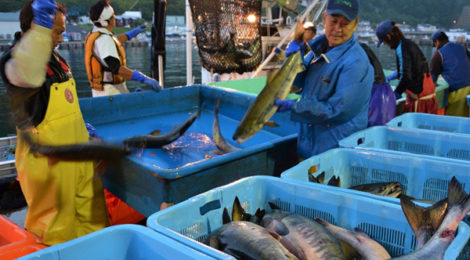
Japanese Salmon Fisheries In Historic Collapse Help On The Way
News from Japan is terrible for NW Pacific fish.
Government report show landings in 2016 in Hokkaido the main salmon port is the lowest in nearly three decades.
Direct fishery losses of nearly $75 million USD have multiplied into economic sector losses of ~$200 million.
Japanese salmon groups now demanding government approve ocean pasture restoration begin this year.
The number of Japanese salmon caught out of its main fishing ports, including Hokkaido, in 2016 plunged 30%-40% from the previous year to 23.4 million fish, according to the survey by the Hokkaido District Fisheries Coordination Committee. The figure represented the lowest level in 28 years. The collapse has been confidently attributed to poor ocean survival, aka starvation, of four-year-old Chum salmon.
Local fishermen have been increasingly concerned over the fact that the trend of meager catch that continued in recent years has not been held in check and indeed is worsening every year. No amount of concern or regulatory restrictions have had any effect on the collapsing NW Salmon populations.
While last year vigorous stormy weather kept many boats in port in the early days of the autumn fishery, the storms quickly abated and the boats sailed in pursuit of the all important Chum salmon with plenty of time left in the fishing season. No improvement in the fishery was forthcoming. Many regions suffered losses as high as 44% and more over the previous years already reduced catches. Given the shortfall of fish and the scrawny condition of the fish that were caught all evidence points to a cataclysmic collapse of ocean pasture primary productivity and fish starving at sea.
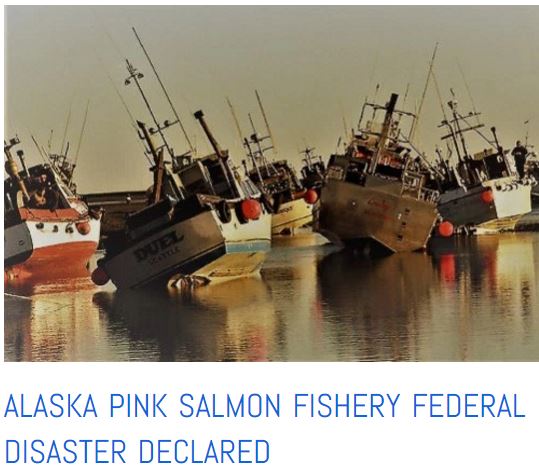
Salmon numbers so low on Alaska’s ocean pastures that federal government declares a state of emergency – click to read more
Not just JAPAN
Across the Pacific ocean salmon pastures have failed and precious salmon have largely starved to death at sea. As a result the new Trump government has declared a national fishery emergency for the fish of Alaska.
According to the federal proclamation, fishing opportunities were terrible last year as a result of poor returns and conditions this year are certain to be far worse. Last year in the Kodiak region, much of the area remained closed for 70 percent of the season. Only 3.2 million fish were harvested in the Kodiak management area, approximately 20 percent of the average catch over the last five years.
This is What Can Bring The Fish Back
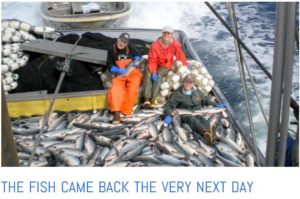
Alaska enjoys largest salmon catch in all of history following ocean fish pasture restoration. click to read more
Some fishermen and organizations are now calling for the government to investigate the potential for ocean pasture restoration which produced a phenomenal restoration of Alaska salmon following the 2012 Gulf of Alaska ocean pasture restoration. That work threw the entire fisheries community into a conundrum as the projected catch of Pink Salmon in Alaska in 2013 was projected to be a very good catch at 50 million fish.
Instead of the 50 million 226 million Pink salmon were caught that year, the largest catch in all of history. The additional ‘pasture fed’ salmon catch according to the State of Alaska delivered more than $700 million USD into the state economy.
More specifically important to the Japanese chum fishery in 2014 the expected Chum returns all along the west coast of North America was also dramatically above projected numbers, in perfect timing with being the result of a thriving ocean fish pasture where the fish were thriving and surviving prior to returning to their home streams and rivers to spawn.
Nature Gives Birth
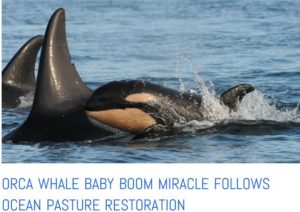
Outstanding maternal nutrition credited with Pacific Northwest Orca baby boom. The fish came back and so arrived a record number of new baby Orca whales.
Added adorable evidence of the success of the Gulf of Alaska ocean pasture restoration came in the form of an unprecedented Orca whale baby boom that followed in perfect harmony with their ocean pasture restored to historic health and abundance and providing vital maternal nutrition leading to the incredible baby boom of whales.
The gestation period of an Orca at 17 months is the longest known of all cetaceans, and all these new baby Orcas says something wonderful must have already happened at just the right time to bring the mother Orca’s back to healthy fertility and new babies into our world.
Mother Orca’s may bear a calf in the best of times only every 3-5 years however in recent times more than a decade has passed between even one Orca birth so it is clear something wonderful happened on the Orca ocean pastures to bring health and abundance back to those pastures. That something wonderful was the intentional and successful restoration of their ocean pasture producing record numbers of their favourite food, salmon.
Restoration of the North Pacific Ocean Pastures To Historic Abundance Sometime Mother Nature’s Volcanoes Now Also With Our Help
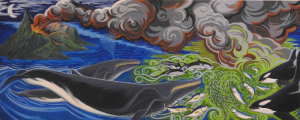
Volcanos like the eruption of Aleutian Island Kasatochi in 2008 bring the ocean to life, but volcanic eruptions are rare, only three in the past 100 years have dusted the ocean pasture at the right time and place. (Painting was commissioned to convey my dream of the wonder of the volcano and ocean pasture restored – artist Leanne Hodges)
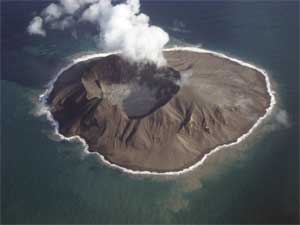
Kasatochi After 2008 Blast – click to read more about how volcano’s restore ocean pastures, consuming CO2, and feeding fish
In 2008 when the Kasatochi volcano in the Aleutian Islands of Alaska erupted in mid-August for a few days a plume of volcanic dust from the violent eruption drifted to the south and east dusting parts of the NE Pacific in the Gulf of Alaska. The volcanos dust arrived very late in the ocean pasture growing season, rather like if you were to plant your vegetable garden in mid August you might well not expect much of a harvest from the late gardening effort.
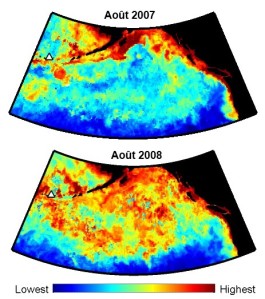
The volcano Kasatochi’s ash dusted the ocean to the south and east and produced a massive ocean pasture bloom in perfect time to feed the Fraser River Sockeye salmon.
Even late in the summer Kasatochi’s mineral rich volcanic ash had a profound effect and the ocean pasture turned from clearest blue to murky green. A rich abundance of ocean plant life, phytoplankton, flourished and bloomed right in the best place, the nursery and rearing pastures of Pacific salmon. The revitalizing dust arrived by an especially well-timed coincidence for the last of the Pacific salmon that go to sea each year, the Sockeye Salmon of the Fraser River (the greatest sockeye salmon watershed of all).
Those Sockeye salmon found their ocean pasture had changed from a desolate blue desert into a flourishing nourishing pasture.
Right on schedule two years later the Sockeye salmon instead of mostly starving at sea returned to the Fraser River near Vancouver in one of the largest returns in history. 4o million salmon can’t be wrong as all agreed.
Japan salmon stewards can and must restore and sustain its vital ocean fish pastures beginning this year, here’s my prescription for Japan’s Mother Nature and fish.
Becoming the volcano
In 2012 after many years of development work I completed a commercial-scale pilot project designed to restore and replenish a vital ocean salmon pasture in the N.E. Pacific. I provided the technology, methodology, and scientific and engineering expertise via a limited technology license and other guiding business agreements with the Haida Salmon Restoration Corporation.
A key element in the project design was that I selected the location and timing for the work so that it would coincide with the migratory behavior of young salmon from SE Alaska, Canada, and the Pacific Northwest.
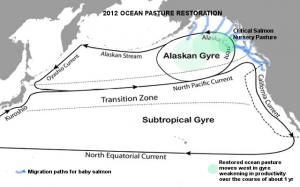
North Pacific Currents Define Salmon Habitat. The Green Pasture Patch Is Our 2012 Restored Ocean Pasture. It’s the most vital salmon nursery where most of the baby salmon from go to put on 95% of their adult body weight. (blue paths show their migratory routes.)
It’s well established that salmon from the rivers and streams of the West Coast of North America must make their way to the Alaskan Gyre where water temperatures and the ecology are matched to salmon biology. There on the ocean pastures those salmon will put on more than 95% of their body weight in the 2-4 years before the urge to return to spawn.
They reach the gyre as babies so it is an all important nursery for them. If the salmon were to go south of the North Pacific Current they would be swept into regions of the Pacific where the water is far too warm for them and which is filled with voracious predatory fish. Survival there is very unlikely.
Doing the same in the ocean of the NW Pacific close to Hokkaido is the obvious thing to do to bring Japanese salmon back. It just works!
I’ve done a life’s work of eco-restoration, going on five decades, but my best work was done in 2012 when with 11 native friends, my dirty dozen, we dusted 10,000 sq. kilometers of the Gulf of Alaska in our ‘salmon restoration’ effort. There is good news to come so do read on, some wonderful happened.
In our distant patch of North Pacific in the summer of 2012 the proof was delivered.
Over the course of many weeks we hefted/man-handled 4,000 50 lb bags of life-giving mineral deck from the holds of the ship to give dust back to the ocean to replenish and restore all of ocean life, from the bottom up.
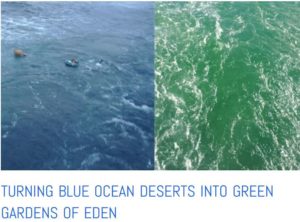
Looking astern off the transom of my research ship before we began our dusting to restore the ocean to health the ocean was a blue desert. After dusting the same view revealed a beautiful emerald-green see that had become full of life. (No Photoshop, raw camera) – click to read more
Where before we began our dusty work in intensive scientific surveys of that dying ocean pasture we rarely saw much of ocean life. A few birds each day was all. Once every few days perhaps one sighting of a whale.
Restoring Japan’s vital salmon pastures could begin in the summer of 2017
It doesn’t require a great deal of money, people, or time. Just a determination to restore the health of Mother Nature. The proof will swim home to Japan in the form of hundreds of millions of additional salmon in just a few short years.
Like any form of sustainable pasture management the work is not one single silver bullet, it will require a yearly effort from now for the foreseeable future. By giving back to Mother Nature she will give back to the fishers and people of Japan the healthiest abundance of salmon ever known.
Join me. I would especially like to hear from Japanese salmon fishers, people, industry and government.









Many statues and schools will be named after Russ George. He is a amazing scientist and should receive the Nobel prize. The World should incorporate his ideas as one of the few solutions to a desperate problem before it is too late.
If Americans hesitate, then maybe Japan will have save the world. Russ George is a hero and will be viewed as such in the future.